Furuno GP-1870F User Manual
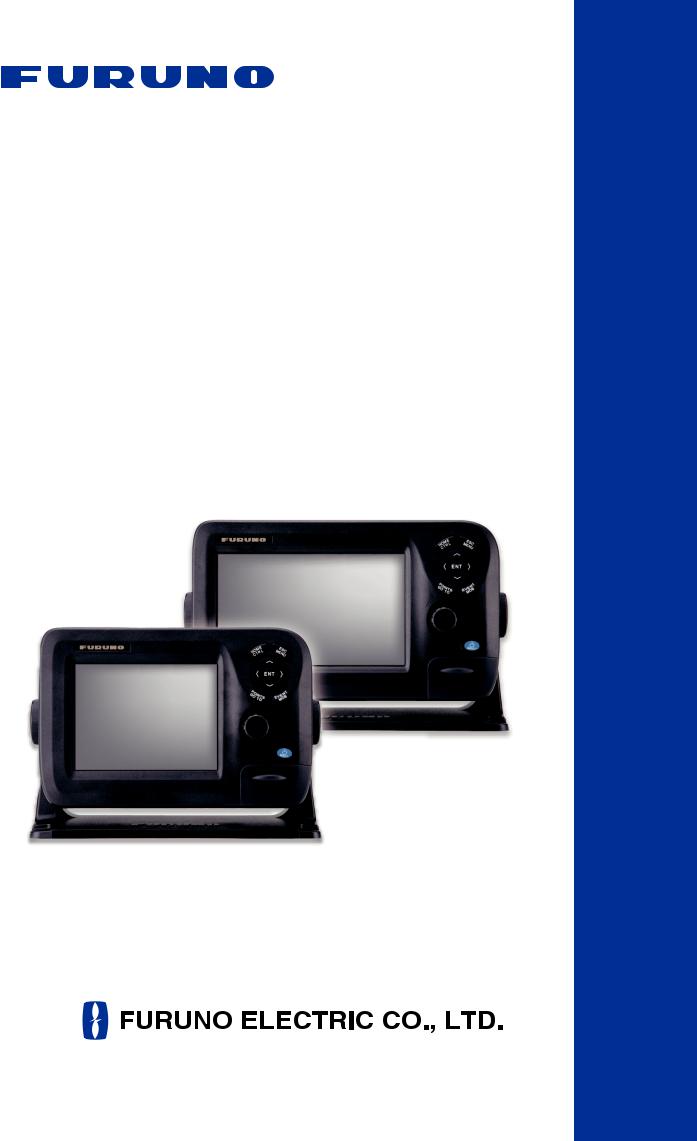
GPS PLOTTER/SOUNDER
Model GP-1670F/GP-1870F
MANUAL OPERATOR'S
www.furuno.com
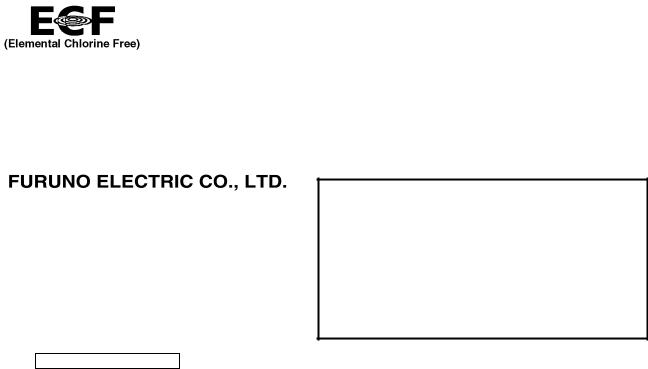
The paper used in this manual is elemental chlorine free.
FURUNO Authorized Distributor/Dealer
9-52 Ashihara-cho,
Nishinomiya, 662-8580, JAPAN
All rights reserved. |
Printed in Japan |
A : JUN . 2012
C : FEB . 15, 2013
Pub. No. OME-44770-C
(TAHA ) GP-1670F/GP-1870F
*00017659312*
*00017659312*
* 0 0 0 1 7 6 5 9 3 1 2 *

IMPORTANT NOTICES
General
•This manual has been authored with simplified grammar, to meet the needs of international users.
•The operator of this equipment must read and follow the descriptions in this manual. Wrong operation or maintenance can cancel the warranty or cause injury.
•Do not copy any part of this manual without written permission from FURUNO.
•If this manual is lost or worn, contact your dealer about replacement.
•The contents of this manual and equipment specifications can change without notice.
•The example screens (or illustrations) shown in this manual can be different from the screens you see on your display. The screens you see depend on your system configuration and equipment settings.
•Save this manual for future reference.
•Any modification of the equipment (including software) by persons not authorized by FURUNO will cancel the warranty.
•SDHC is a registered trademark of SD-3C, LLC.
•All brand and product names are trademarks, registered trademarks or service marks of their respective holders.
How to discard this product
Discard this product according to local regulations for the disposal of industrial waste. For disposal in the USA, see the homepage of the Electronics Industries Alliance (http://www.eiae.org/) for the correct method of disposal.
How to discard a used battery
Some FURUNO products have a battery(ies). To see if your product has a battery, see the chapter on Maintenance. Follow the instructions below if a battery is used. Tape the + and - terminals of battery before disposal to prevent fire, heat generation caused by short circuit.
In the European Union
The crossed-out trash can symbol indicates that all types of batteries must not be discarded in standard trash, or at a trash site. Take the
used batteries to a battery collection site according to your national 
 Cd legislation and the Batteries Directive 2006/66/EU.
Cd legislation and the Batteries Directive 2006/66/EU.
In the USA
The Mobius loop symbol (three chasing arrows) indicates that Ni-Cd and lead-acid rechargeable batteries must be recycled. Take the used
batteries to a battery collection site according to local laws.
Ni-Cd Pb
In the other countries
There are no international standards for the battery recycle symbol. The number of symbols can increase when the other countries make their own recycle symbols in the future.
i
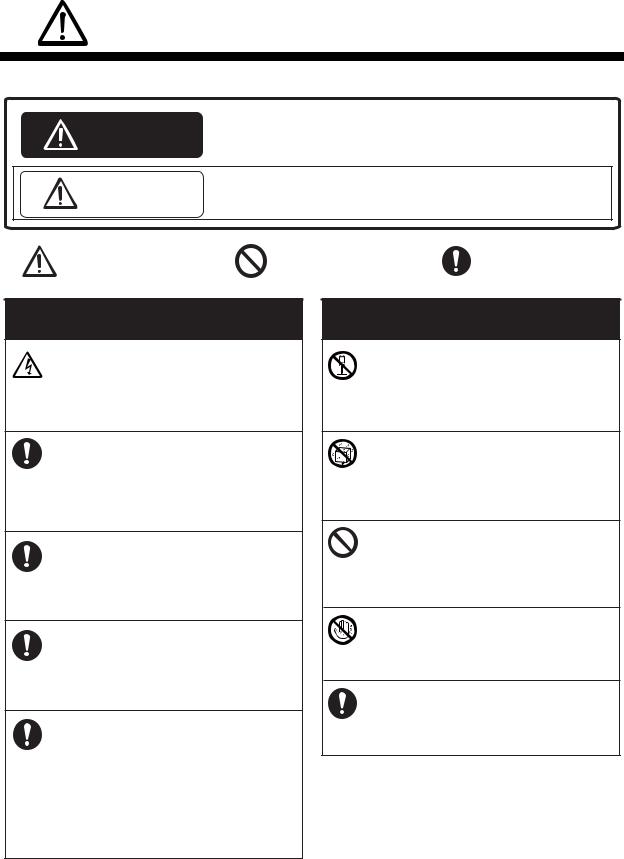
SAFETY INSTRUCTIONS
The operator must read the safety instructions before attempting to operate the equipment.
|
WARNING |
could result in death or serious injury. |
|
|
|
|
Indicates a potentially hazardous situation which, if not avoided, |
|
|
|
|
|
|
|
|
CAUTION |
Indicates a potentially hazardous situation which, if not avoided, |
|
|
|
could result in minor or moderate injury. |
|
|
|
|
|
|
|
|
|
Warning, Caution |
Prohibitive Action |
Mandatory Action |
|
|
|
|
|
|
 WARNING
WARNING
Do not open the equipment.
The equipment uses high voltage that can cause electrical shock. Refer any repair work to a qualified technician.
If water leaks into the equipment or something is dropped into the equipment, immediately turn off the power at the switchboard.
Fire or electrical shock can result.
If the equipment is giving off smoke or fire, immediately turn off the power
at the switchboard.
WARNING
Fire or electrical shock can result.
If you feel the equipment is acting abnormally or giving off strange noises, immediately turn off the power at the switchboard and contact a FURUNO service technician.
Electrical current flows to the pins of the transducer connector when the power is on, regardless of whether the transducer cable is connected or not.
If the transducer cable is not connected, cover the transducer connector with the supplied cap to prevent electrical shock.
 WARNING
WARNING
Do not disassemble or modify the equipment.
Fire, electrical shock or serious injury can result.
Make sure no rain or water splash leaks into the equipment.
Fire or electrical shock can result if water leaks into the equipment.
Do not place liquid-filled containers on or near the equipment.
Fire or electrical shock can result if a liquid spillsWARNINGinto the equipment.
Do not operate the equipment with wet hands.
Electrical shock can result.
Use the proper fuse.
Use of the wrong fuse can cause fire or electrical shock.
ii
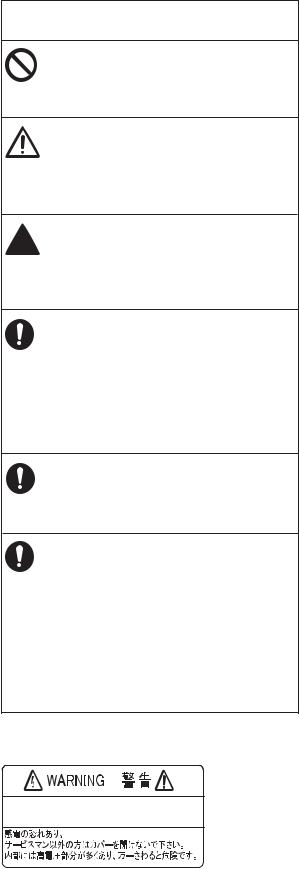
SAFETY INSTRUCTIONS
 CAUTION
CAUTION
Do no turn on the equipment with the transducer out of water.
The transducer can be damaged.
The picture is not refreshed when picture advancement is stopped.
Maneuvering the vessel in this condition can result in a dangerous situation.
 Adjust the gain correctly.
Adjust the gain correctly.
Incorrect gain may give a wrong depth indication, which could result in a dangerous situation.
The data presented by this equipment is intended as a source of navigation information.
The prudent navigator never relies exclusively on any one source of navigation information, for safety of vessel and crew.
The LCD panel is made of glass.
Handle it with care.
Injury can result if the glass breaks.
Follow the compass safe distances shown below to prevent interference to a magnetic compass.
|
Standard |
Steering |
|
compass |
compass |
GP-1670F |
0.30 m |
0.30 m |
|
|
|
GP-1870F |
0.30 m |
0.30 m |
|
|
|
Warning Label
Do not remove the label.
To avoid electrical shock,do not remove cover. No user-serviceable parts inside.
Warning Label
iii
TABLE OF CONTENTS
|
|
|
|
|
...................................................................................................................FOREWORD |
|
ix |
||
SYSTEM CONFIGURATION .......................................................................................... |
xi |
|||
EQUIPMENT LISTS....................................................................................................... |
xii |
|||
1. |
OPERATIONAL OVERVIEW ................................................................................. |
1-1 |
||
|
1.1 |
Controls...................................................................................................................... |
1-1 |
|
|
|
1.1.1 |
Control description ......................................................................................... |
1-1 |
|
1.2 |
RotoKeyTM and Soft Controls .................................................................................... |
1-5 |
|
|
1.3 |
How to Turn the Power On or Off............................................................................... |
1-6 |
|
|
1.4 |
How to Adjust the Display Brilliance........................................................................... |
1-6 |
|
|
1.5 |
2D Plotter Displays..................................................................................................... |
1-6 |
|
|
1.6 |
The Cursor ................................................................................................................. |
1-9 |
|
|
1.7 |
Navigation Data Boxes............................................................................................. |
1-10 |
|
|
|
1.7.1 How to select the data to display in a box.................................................... |
1-10 |
|
|
1.8 |
Home Screen (Display Selection) ............................................................................ |
1-11 |
|
|
|
1.8.1 How to select a display ................................................................................ |
1-11 |
|
|
|
1.8.2 How to switch the active screen................................................................... |
1-11 |
|
|
|
1.8.3 How to customize the home screen............................................................. |
1-12 |
|
|
|
1.8.4 Description of home screen displays ........................................................... |
1-14 |
|
|
1.9 |
Display Range.......................................................................................................... |
1-18 |
|
|
1.10 |
Orientation Mode...................................................................................................... |
1-18 |
|
|
1.11 |
How to Move the Chart ............................................................................................ |
1-19 |
|
|
1.12 |
Menu Operation ....................................................................................................... |
1-20 |
|
|
1.13 |
Object Information.................................................................................................... |
1-21 |
|
|
|
1.13.1 |
Simple information ....................................................................................... |
1-21 |
|
|
1.13.2 |
Detailed information ..................................................................................... |
1-21 |
|
1.14 |
Context-Sensitive Menus ......................................................................................... |
1-22 |
|
|
1.15 |
Man Overboard (MOB)............................................................................................. |
1-24 |
|
|
|
1.15.1 |
How to mark MOB position .......................................................................... |
1-24 |
|
|
1.15.2 |
How to stop navigating to a MOB mark........................................................ |
1-24 |
|
|
1.15.3 How to erase an MOB mark......................................................................... |
1-24 |
|
|
1.16 |
How to Take a Screenshot....................................................................................... |
1-24 |
|
|
1.17 |
Tide Information ....................................................................................................... |
1-25 |
|
|
|
1.17.1 |
Tide height information................................................................................. |
1-25 |
|
|
1.17.2 |
Tide stream information ............................................................................... |
1-26 |
2. |
TRACK ................................................................................................................... |
|
2-1 |
|
|
2.1 |
How to Show, Hide all Track ...................................................................................... |
2-1 |
|
|
2.2 |
How to Stop Recording Track .................................................................................... |
2-1 |
|
|
2.3 |
How to Select Recording Method, Recording In-terval .............................................. |
2-1 |
|
|
2.4 |
How to Change the Color of Your Boat’s Track ......................................................... |
2-2 |
|
|
2.5 |
How to Change the Color of Your Boat’s Track with Sea Surface Temperature ....... |
2-2 |
|
|
2.6 |
How to Hide, Show Track by Color ............................................................................ |
2-2 |
|
|
2.7 |
How to Delete Track by Color .................................................................................... |
2-3 |
|
|
2.8 |
How to Find Track Information ................................................................................... |
2-3 |
|
3. |
POINTS .................................................................................................................. |
|
3-1 |
|
|
3.1 |
What is a Point? ......................................................................................................... |
3-1 |
|
|
3.2 |
How to Enter a Point .................................................................................................. |
3-1 |
|
|
|
3.2.1 How to enter a point at the current position ................................................... |
3-1 |
|
|
|
3.2.2 How to enter a point at the cursor position..................................................... |
3-2 |
|
iv
|
|
|
|
TABLE OF CONTENTS |
|
|
3.2.3 |
How to enter a position manually on the plotter screen ................................. |
3-3 |
|
|
3.2.4 |
How to enter a point from the Points List ....................................................... |
3-3 |
|
3.3 |
How to Find Detailed Point Information...................................................................... |
3-4 |
|
|
3.4 |
How to Move a Point .................................................................................................. |
3-4 |
|
|
|
3.4.1 |
How to move a point on the screen................................................................ |
3-4 |
|
|
3.4.2 |
How to move a point from the Points List....................................................... |
3-4 |
|
3.5 |
How to Select Visibility for Points ............................................................................... |
3-5 |
|
|
3.6 |
How to Search, Sort Points on the Points List............................................................ |
3-5 |
|
|
|
3.6.1 |
How to search points...................................................................................... |
3-5 |
|
|
3.6.2 |
How to sort points........................................................................................... |
3-5 |
|
3.7 |
How to Filter Points by Shape on the Points List........................................................ |
3-6 |
|
|
3.8 |
How to Delete Points.................................................................................................. |
3-6 |
|
|
|
3.8.1 |
How to delete a point from the screen............................................................ |
3-6 |
|
|
3.8.2 |
How to delete points from the Points List ....................................................... |
3-6 |
4. |
ROUTES ................................................................................................................ |
|
4-1 |
|
|
4.1 |
What is a Route?........................................................................................................ |
4-1 |
|
|
4.2 |
How to Create a Route............................................................................................... |
4-1 |
|
|
|
4.2.1 |
How to create a route from the RotoKey menu .............................................. |
4-1 |
|
|
4.2.2 |
How to create a route from the Routes List.................................................... |
4-2 |
|
|
4.2.3 |
How to create a route with the Easy Routing feature ..................................... |
4-3 |
|
4.3 |
How to Extend a Route on the Screen ....................................................................... |
4-6 |
|
|
4.4 |
How to Insert a Point on a Route on the Screen ........................................................ |
4-7 |
|
|
4.5 |
How to Move a Point in a Route on the Screen.......................................................... |
4-7 |
|
|
4.6 |
How to Delete a Point From a Route on the Screen .................................................. |
4-7 |
|
|
4.7 |
Routes List.................................................................................................................. |
4-8 |
|
|
|
4.7.1 |
How to display the Routes List ....................................................................... |
4-8 |
|
|
4.7.2 |
Functions available in the Routes List............................................................ |
4-9 |
|
4.8 |
Route Report, Route Calculator ............................................................................... |
4-10 |
|
|
4.9 |
How to Display a Route on the Screen..................................................................... |
4-11 |
|
|
4.10 |
How to Connect Two Routes.................................................................................... |
4-11 |
|
|
4.11 |
Simple Route Information......................................................................................... |
4-11 |
|
|
4.12 |
How to Rename a Route on the Screen................................................................... |
4-12 |
|
|
4.13 |
How to Delete Routes............................................................................................... |
4-12 |
|
|
|
4.13.1 |
How to delete a route on the screen ............................................................ |
4-12 |
|
|
4.13.2 |
How to delete routes from the Routes List ................................................... |
4-12 |
5. |
NAVIGATION......................................................................................................... |
5-1 |
||
|
5.1 |
How to Navigate to a Quick Point............................................................................... |
5-1 |
|
|
5.2 |
How to Navigate to a Saved Point.............................................................................. |
5-2 |
|
|
|
5.2.1 |
How to navigate to a saved point selected on the screen .............................. |
5-2 |
|
|
5.2.2 |
How to navigate to a point selected from the Points List................................ |
5-2 |
|
5.3 |
How to Select a Route for Navigation......................................................................... |
5-2 |
|
|
|
5.3.1 |
On-screen route ............................................................................................. |
5-2 |
|
|
5.3.2 |
Route selected from the Routes List .............................................................. |
5-3 |
|
|
5.3.3 |
How to start navigation from a point on a route.............................................. |
5-3 |
|
5.4 |
Functions Available When You Follow a Route.......................................................... |
5-4 |
|
|
|
5.4.1 |
Restart navigation .......................................................................................... |
5-4 |
|
|
5.4.2 |
Follow a route in reverse order....................................................................... |
5-4 |
|
|
5.4.3 |
Stop following a route..................................................................................... |
5-4 |
|
|
5.4.4 |
Skip a leg in a route........................................................................................ |
5-4 |
6.MAP SETTINGS, 2D PERSPECTIVE/3D DISPLAYS AND
SATELLITE OVERLAY ......................................................................................... |
6-1 |
|
6.1 |
Map Setup .................................................................................................................. |
6-1 |
6.2 |
2D Perspective Dispay ............................................................................................... |
6-5 |
v
TABLE OF CONTENTS |
|
|||
|
6.3 |
3D Display.................................................................................................................. |
6-6 |
|
|
|
6.3.1 |
3D display description .................................................................................... |
6-6 |
|
|
6.3.2 |
How to tilt and rotate the 3D display .............................................................. |
6-7 |
|
|
6.3.3 |
How to make the 3D view clearer .................................................................. |
6-7 |
|
6.4 |
Satellite Photo Overlay............................................................................................... |
6-8 |
|
7. |
FISH FINDER OPERATIONS ................................................................................ |
7-1 |
||
|
7.1 |
How the Fish Finder Works........................................................................................ |
7-1 |
|
|
7.2 |
Fish Finder Display .................................................................................................... |
7-2 |
|
|
7.3 |
How to Activate the Fish Finder ................................................................................. |
7-3 |
|
|
7.4 |
How to Select a Display ............................................................................................. |
7-3 |
|
|
|
7.4.1 |
How to select a single frequency or dual frequency ....................................... |
7-3 |
|
|
7.4.2 |
How to select a zoom display ......................................................................... |
7-4 |
|
|
7.4.3 |
A - scope display .............................................................................................. |
7-5 |
|
|
7.4.4 |
Bottom discrimination display ......................................................................... |
7-6 |
|
7.5 |
Automatic Fish Finder ................................................................................................ |
7-8 |
|
|
|
7.5.1 |
How the automatic fish finder works .............................................................. |
7-8 |
|
|
7.5.2 |
How to select an automatic fish finder mode ................................................. |
7-8 |
|
|
7.5.3 |
How to adjust the gain in the auto mode ........................................................ |
7-8 |
|
7.6 |
Manual Fish Finder Operation.................................................................................... |
7-9 |
|
|
|
7.6.1 |
How to select a display range ........................................................................ |
7-9 |
|
|
7.6.2 |
How to shift the range .................................................................................... |
7-9 |
|
|
7.6.3 |
How to adjust the gain .................................................................................. |
7-10 |
|
|
7.6.4 |
How to reduce clutter ................................................................................... |
7-10 |
|
7.7 |
Picture Advance Speed............................................................................................ |
7-11 |
|
|
7.8 |
How to Reduce Interference .................................................................................... |
7-12 |
|
|
7.9 |
How to Erase Weak Echoes .................................................................................... |
7-12 |
|
|
7.10 |
How to Measure Depth, Time Between Locations ................................................... |
7-13 |
|
|
7.11 |
How to Balance Echo Strength ................................................................................ |
7-13 |
|
|
7.12 |
White Marker............................................................................................................ |
7-14 |
|
|
7.13 |
White Line ................................................................................................................ |
7-14 |
|
|
7.14 |
Alarms |
...................................................................................................................... |
7-14 |
|
|
7.14.1 |
How to set an alarm ..................................................................................... |
7-15 |
|
|
7.14.2 ................... |
How to select the echo signal level that triggers the fish alarm |
7-15 |
|
7.15 |
ACCU- .........................................................................................................FISHTM |
7-16 |
|
|
|
7.15.1 ............................................................... |
Considerations for ACCU - FISH TM |
7-16 |
|
|
7.15.2 ......................... |
How to activate ACCU - FISH TM , select display information |
7-17 |
|
|
7.15.3 ...................................................................................... |
Fish size correction |
7-17 |
|
7.16 |
Water Temperature .......................................................................................Graph |
7-18 |
|
|
7.17 |
FISH FINDER .................................................................................................Menu |
7-19 |
|
|
7.18 |
Interpreting ............................................................................................the Display |
7-22 |
|
8. |
ALARMS ................................................................................................................ |
|
8-1 |
|
|
8.1 |
ALARMS ..........................................................................................................Menu |
8-1 |
|
|
8.2 |
Audio Alarm ..............................................................................................Conditions |
8-2 |
|
|
8.3 |
Arrival ...............................................................................................................Alarm |
8-2 |
|
|
8.4 |
XTE Alarm.................................................................................................................. |
8-3 |
|
|
8.5 |
Temperature ....................................................................................................Alarm |
8-3 |
|
|
8.6 |
Shear Alarm ............................................................................................................... |
8-4 |
|
|
8.7 |
Depth Alarm ............................................................................................................... |
8-4 |
|
|
8.8 |
Anchor .............................................................................................................Alarm |
8-5 |
|
|
8.9 |
Trip Alarm................................................................................................................... |
8-5 |
|
|
8.10 |
Speed ..............................................................................................................Alarm |
8-5 |
|
|
8.11 |
Fuel Tank .........................................................................................................Alarm |
8-6 |
|
|
8.12 |
Water Tank ......................................................................................................Alarm |
8-6 |
|
|
8.13 |
Black Water ............................................................................................Tank Alarm |
8-6 |
|
vi
|
|
|
TABLE OF CONTENTS |
9. |
MEMORY CARD OPERATIONS ........................................................................... |
9-1 |
|
|
9.1 |
The Memory Card Screen .......................................................................................... |
9-1 |
|
9.2 |
How to Initialize SD Cards.......................................................................................... |
9-1 |
|
9.3 |
How to Eject an SD Card............................................................................................ |
9-2 |
|
9.4 |
How to Save Data to an SD Card............................................................................... |
9-2 |
|
9.5 |
How to Rename Files on an SD Card ........................................................................ |
9-2 |
|
9.6 |
How to Delete Files from an SD Card ........................................................................ |
9-3 |
|
|
9.6.1 |
9-3 |
|
|
9.6.2 |
9-3 |
|
9.7 |
How to Import Data from an SD Card......................................................................... |
9-3 |
|
9.8 |
How to Process Screenshots ..................................................................................... |
9-4 |
|
|
9.8.1 |
9-4 |
|
|
9.8.2 |
9-4 |
|
|
9.8.3 |
9-5 |
10. OTHER FUNCTIONS .......................................................................................... |
10-1 |
||
|
10.1 |
AIS Operations ......................................................................................................... |
10-1 |
|
|
10.1.1 |
10-1 |
|
|
10.1.2 |
10-2 |
|
|
10.1.3 |
10-2 |
|
|
10.1.4 |
10-2 |
|
10.2 |
DSC Message Information ....................................................................................... |
10-3 |
|
|
10.2.1 |
10-3 |
|
|
10.2.2 |
10-3 |
|
10.3 |
Stopwatch, Timer...................................................................................................... |
10-4 |
|
10.4 |
How to Select Input, Output Data............................................................................. |
10-5 |
|
|
10.4.1 |
10-5 |
|
|
10.4.2 |
10-6 |
|
10.5 |
Engine Display Setup (INSTRUMENTS menu)........................................................ |
10-7 |
11. CUSTOMIZING YOUR UNIT ............................................................................... |
11-1 |
||
|
11.1 |
GENERAL Menu ...................................................................................................... |
11-1 |
|
11.2 |
PLOTTER Menu....................................................................................................... |
11-2 |
|
11.3 |
SYSTEM Menu......................................................................................................... |
11-3 |
12. |
MAINTENANCE, TROUBLESHOOTING ............................................................ |
12-1 |
|
|
12.1 |
Maintenance............................................................................................................. |
12-1 |
|
12.2 |
How to Replace the Fuse ......................................................................................... |
12-2 |
|
12.3 |
Troubleshooting........................................................................................................ |
12-2 |
|
12.4 |
GPS Status Display .................................................................................................. |
12-4 |
|
12.5 |
How to Restore Defaults, Clear Memory .................................................................. |
12-5 |
|
12.6 |
System Information................................................................................................... |
12-6 |
13. INSTALLATION ................................................................................................... |
13-1 |
||
|
13.1 |
Installation of Display Unit ........................................................................................ |
13-1 |
|
13.2 |
Installation of Antenna Unit....................................................................................... |
13-2 |
|
13.3 |
Installation or Transducers ....................................................................................... |
13-2 |
|
|
13.3.1 |
13-2 |
|
|
13.3.2 |
13-5 |
|
|
13.3.3 |
13-6 |
|
|
13.3.4 |
13-7 |
|
13.4 |
Installation of Sensors (option) ............................................................................... |
13-12 |
|
|
13.4.1 |
13-12 |
|
|
13.4.2 |
13-13 |
|
13.5 |
Wiring |
13-15 |
|
13.6 |
Initial Settings ......................................................................................................... |
13-19 |
vii
TABLE OF CONTENTS |
|
|
13.6.1 INSTALLATION SETTINGS menu |
............................................................. 13-19 |
|
13.6.2 CAN bus input/output................................................................................. |
13-21 |
|
APPENDIX 1 |
MENU TREE ....................................................................................... |
AP-1 |
APPENDIX 2 |
ABBREVIATIONS, SYMBOLS ........................................................... |
AP-6 |
APPENDIX 3 |
JIS CABLE GUIDE ........................................................................... |
AP-11 |
SPECIFICATIONS ..................................................................................................... |
SP-1 |
|
PACKING LISTS.......................................................................................................... |
A-1 |
|
OUTLINE DRAWINGS................................................................................................. |
D-1 |
|
INTERCONNECTION DIAGRAM ................................................................................ |
S-1 |
|
INDEX.......................................................................................................................... |
|
IN-1 |
viii

FOREWORD
A Word to GP-1670F, GP-1870F Owners
Congratulations on your choice of the FURUNO GP-1670F, GP-1870F GPS Plotter/Sounder. We are confident you will see why the FURUNO name has become synonymous with quality and reliability.
Since 1948, FURUNO Electric Company has enjoyed an enviable reputation for innovative and dependable marine electronics equipment. This dedication to excellence is furthered by our extensive global network of agents and dealers.
This equipment is designed and constructed to meet the rigorous demands of the marine environment. However, no machine can perform its intended function unless operated and maintained properly. Please carefully read and follow the recommended procedures for operation and maintenance.
We would appreciate hearing from you, the end user, about whether we are achieving our purposes.
Thank you for considering and purchasing FURUNO equipment.
Features
The GP-1670F and GP-1870F provide a totally integrated GPS receiver, color video plotter and color fish finder. The built-in GPS receiver provides highly accurate position, course and speed information. The fish finder presents vivid underwater images on a high quality LCD. The compact display unit and antenna unit permit installation where space is limited.
The main features are
General
•Bright 5.7-inch (GP-1670F) or 7-inch (GP-1870F) color LCD with brilliance control.
•Excellent viewing angles, even when wearing sunglasses.
•Internal GPS receiver provides highly accurate position information (GPS, within 2.5 m, SBAS, within 2 m).
•Customizable analog and digital displays show wind angle and speed, engine condition (speed, temperature, oil pressure, etc.), etc.
•Large internal memory stores 30,000 track points, 30,000 points, 1,000 routes (500 waypoints/ route).
•SD card slot accepts SD and SDHC cards for external storage of data and settings.
•Full range of alarms: Arrival, Anchor Watch, Cross-track Error, Speed, Depth, Temperature, Fish Alarm, Bottom Alarm, etc.
•Man overboard (MOB) feature records latitude and longitude coordinates at the time of MOB.
•CAN bus interface for the connection of GPS Receiver, Weather Station, FI-50 (instrument series), Satellite Compass, etc.
•Accepts NMEA0183 input with optional NMEA data converter.
•Internal GPS antenna available.
•C-Map 4D charts available.
ix
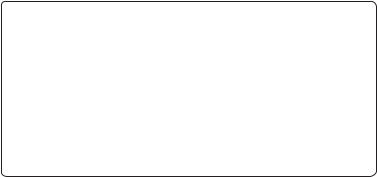
FOREWORD
Fish finder
•Fish finder measures the depth to the bottom and displays underwater conditions in multi-col- ors* according to echo strength. A monochrome presentation shows the echoes in shades of gray. (*Number of colors depends on network sounder, color sounder.).
•Automatic and manual fish finder operation. Auto mode automatically adjusts range, gain and clutter ac-cording to purpose - fishing or cruising.
•Wide variety of zoom modes for detailed observation of fish and bottom.
•ACCU-FISHTM provides length and depth of individual fish. Appropriate transducer required.
Other
•AIS function (requires connection to an AIS transponder) provides navigational information from AIS transponder equipped vessels within 50 nm.
•Instrument displays (steering, engine, weather, and wind) with connection of relevant sensors.
•DSC (Digital Selective Calling) function alerts to DSC messages received and position requests. (Requires DSC capable radiotelephone.)
Open Source Acknowledgement
This product makes use of the following open source software:
FreeType (www.freetype.org)
Portions of this software are copyright ©2009 The FreeType Project (www.freetype.org). All rights reserved.
libpng (http://www.libpng.org/)
This software is based in part on the work of the Independent JPEG Group.
libjpeg (http://www.ijg.org/)
We would like to thank each developer of the above-mentioned open source software for their great contribution to the open source community.
x
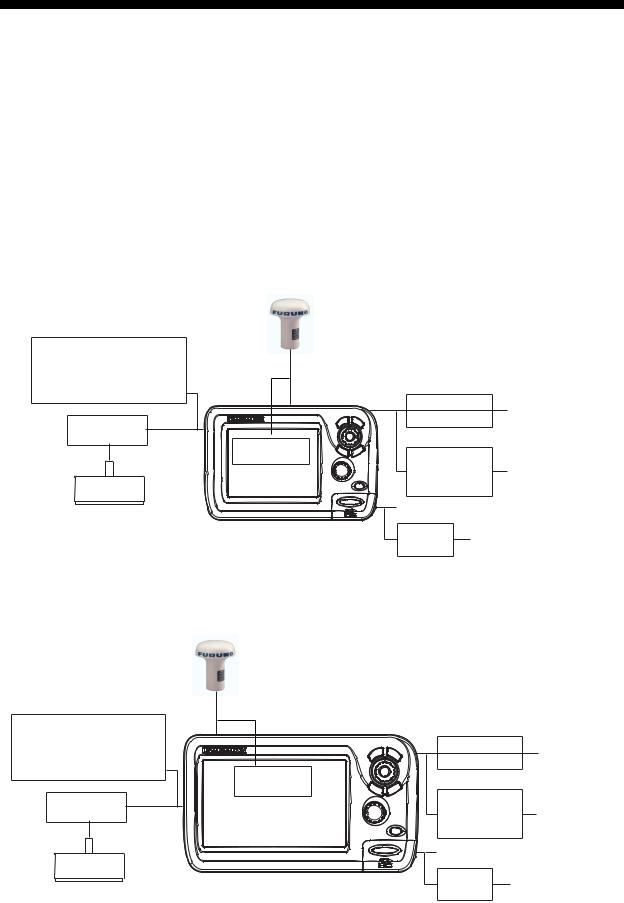
SYSTEM CONFIGURATION
The environmental category of each unit is as follows:
Unit |
Environmental category |
|
|
Display unit |
Protected from the weather |
|
|
GPS antenna unit |
Exposed to the weather, or protected from the weather in |
|
case of internal antenna |
|
|
Transducer, sensor |
Submerged in water |
|
|
Other units |
Protected from the weather |
|
|
GP-1670F
Water temp./speed sensor ST-02MSB, ST-02PSB Water temp. sensor
T-02MSB, T-02MTB, T-03MSB
Matching Box
MB-1100*
Transducer
Antenna Unit
GPA-017 or
GPA-017S
OR
Display Unit
GP-1670F
Internal GPS antenna
520-5PSD, 520-5MSD,
525-5PWD, 525STID-MSD, * For connection to 1 kW 525STID-PWD transducer (50B-6, 50B-6B,
200B-5S, 50/200-1T, 50/200-12M)
Junction Box |
CAN bus |
FI-5002 |
equipment |
NMEA Data
Converter NMEA 0183 IF-NMEA2K2 equipment
12-24 VDC
Rectifier
100/110/
PR-62 220/230 VAC,
1ø, 50/60 Hz
GP-1870F
Antenna Unit
GPA-017 or
GPA-017S
Water temp./speed sensor ST-02MSB, ST-02PSB Water temp. sensor
T-02MSB, T-02MTB, T-03MSB
Matching Box
MB-1100*
Transducer
520-5PSD, 520-5MSD,
525-5PWD, 525STID-MSD, 525STID-PWD
OR |
Display Unit |
|
GP-1870F |
||
|
Internal GPS antenna
* For connection to 1 kW transducer (50B-6, 50B-6B, 200B-5S, 50/200-1T, 50/200-12M)
Junction Box |
CAN bus |
FI-5002 |
equipment |
NMEA Data
Converter
NMEA 0183
IF-NMEA2K2 equipment
12-24 VDC
Rectifier
100/110/
PR-62 220/230 VAC,
1ø, 50/60 Hz
xi

EQUIPMENT LISTS
Standard supply
Name |
Type |
Code no. |
Qty |
Remarks |
|
|
|
|
|
Display Unit |
GP-1670F |
- |
Select |
|
|
|
|
one |
|
Display Unit |
GP-1870F |
- |
|
|
|
|
|||
|
|
|
|
|
Installation |
CP14-07100 |
000-021-070 |
1 set |
w/CP14-07101, MJ-A3SPF0013A- |
Materials |
|
|
|
035C (power cable) |
|
|
|
|
|
Spare Parts |
SP14-03501 |
001-184-710 |
1 set |
|
|
|
|
|
|
Accessories |
FP14-03001 |
001-184-730 |
1 set |
For GP-1670F |
|
|
|
|
|
|
FP14-03201 |
001-183-120 |
1 set |
For GP-1870F |
|
|
|
|
|
Optional equipment
Name |
Type |
Code no. |
Remarks |
|
|
|
|
|
|
Replacement Kit |
OP14-72 |
001-184-750 |
|
|
|
|
|
|
|
Waterproofing Cap |
LTWCAP-WBDMMSA1 |
000-167-169-11 |
|
|
|
|
|
|
|
Antenna Unit |
GPA-017 |
|
|
|
|
|
|
|
|
Antenna Unit |
GPA-017S |
|
|
|
|
|
|
|
|
Mast Mtg. Kit |
CP20-01111 |
004-365-780 |
|
|
|
|
|
|
|
Antenna Cable Set |
CP20-01700 *30M* |
004-372-110 |
|
|
|
|
|
|
|
Antenna Cable Set |
CP20-01710 *50M* |
004-372-120 |
|
|
|
|
|
|
|
Transducer |
520-5PSD |
000-015-204 |
Thru-hull mount, plastic |
|
|
|
|
|
|
|
520-5MSD |
000-015-212 |
Thru-hull mount, metal |
|
|
|
|
|
|
|
525-5PWD |
000-146-966-01 |
Transom mount, plastic |
|
|
|
|
|
|
Triducer (transducer |
525STID-MSD |
000-011-783 |
Thru-hull mount, metal |
|
with speed/ temper- |
|
|
|
|
525STID-PWD |
000-011-784 |
Transom mount, plastic |
||
ature sensor) |
||||
|
|
|
||
|
|
|
|
|
Transducer (1 Kw) |
50B-6 |
000-015-042 |
10 m, 1 kW |
|
|
|
|
|
|
|
50B-6B |
000-015-043 |
15 m, 1 kW |
|
|
|
|
|
|
|
200B-5S |
000-015-029 |
10 m, 1 kW |
|
|
|
|
|
|
|
50/200-1T |
000-015-170 |
10 m, 1 kW |
|
|
|
|
|
|
|
50/200-12M |
000-015-171 |
10 m, 1 kW |
|
|
|
|
|
|
Speed/ Tempera- |
ST-02MSB |
000-137-986-01 |
Thru-hull type, metal |
|
ture Sensor |
|
|
|
|
ST-02PSB |
000-137-987-01 |
Thru-hull type, plastic |
||
|
||||
|
|
|
|
xii
|
|
|
EQUIPMENT LISTS |
|
|
|
|
|
|
Name |
Type |
Code no. |
Remarks |
|
|
|
|
|
|
Temperature Sen- |
T-02MTB |
000-040-026 |
Transom mount, 8 m cable |
|
sor |
|
|
|
|
T-02MSB |
000-040-040 |
Thru-hull type |
||
|
||||
|
|
|
|
|
|
T-03MSB |
000-040-027 |
Thru-hull type, 8 m cable |
|
|
|
|
|
|
Matching Box |
MB-1100 |
000-041-353 |
For connection to 1 kW trans- |
|
|
|
|
ducer |
|
|
|
|
|
|
Rectifier |
PR-62 |
000-013-484 |
100 VAC |
|
|
|
|
|
|
Rectifier |
PR-62 |
000-013-485 |
110 VAC |
|
|
|
|
|
|
Rectifier |
PR-62 |
000-013-486 |
220 VAC |
|
|
|
|
|
|
Rectifier |
PR-62 |
000-013-487 |
230 VAC |
|
|
|
|
|
|
Junction Box |
FI-5002 |
|
|
|
|
|
|
|
|
Right Angle Mount- |
No.13QA330 |
001-111-910-10 |
|
|
ing Base |
|
|
|
|
|
|
|
|
|
L-angle Mounting |
No.13-QA310 |
001-111-900-10 |
|
|
Base |
|
|
|
|
|
|
|
|
|
Handrail Mounting |
No.13-RC5160 |
001-111-920-10 |
|
|
Base |
|
|
|
|
|
|
|
|
|
Cable Assy. |
TNC-PS-/PS-3D-L15M-R |
001-173-110-10 |
|
|
|
|
|
|
|
Cable Assy. |
M12-05BM+05BF-010 |
001-105-750-10 |
w/connectors (light), 1 m |
|
|
|
|
|
|
Cable Assy. |
M12-05BM+05BF-020 |
001-105-760-10 |
w/connectors (light), 2 m |
|
|
|
|
|
|
Cable Assy. |
M12-05BM+05BF-060 |
001-105-770-10 |
w/connectors (light), 6 m |
|
|
|
|
|
|
Cable Assy. |
M12-05BFFM-010 |
001-105-780-10 |
w/connectors (light), 1 m |
|
|
|
|
|
|
Cable Assy. |
M12-05BFFM-020 |
001-105-790-10 |
w/connectors (light), 2 m |
|
|
|
|
|
|
Cable Assy. |
M12-05BFFM-060 |
001-105-800-10 |
w/connectors (light), 6 m |
|
|
|
|
|
|
Cable Assy. |
CB-05PM+05BF-010 |
000-167-968-10 |
w/connectors (heavy), 1 m |
|
|
|
|
|
|
Cable Assy. |
CB-05PM+05BF-020 |
000-167-969-10 |
w/connectors (heavy), 2 m |
|
|
|
|
|
|
Cable Assy. |
CB-05PM+05BF-060 |
000-167-970-10 |
w/connectors (heavy), 6 m |
|
|
|
|
|
|
Cable Assy. |
CB-05BFFM-010 |
000-167-971-10 |
w/connectors (heavy), 1 m |
|
|
|
|
|
|
Cable Assy. |
CB-05BFFM-020 |
000-167-972-10 |
w/connectors (heavy), 2 m |
|
|
|
|
|
|
Cable Assy. |
CB-05BFFM-060 |
000-167-973-10 |
w/connectors (heavy), 6 m |
|
|
|
|
|
|
Micro T-connector |
SS-050505-FMF-TS001 |
000-168-603-10 |
Micro style: 3 |
|
|
|
|
|
|
Mini/Micro T-con- |
NC-050505-FMF-TS001 |
000-160-507-10 |
Mini style: 2, micro style: 1 |
|
nector |
|
|
|
|
|
|
|
|
|
Termination Resis- |
LTWMN-05AMMT- |
000-160-508-10 |
Mini style, male, termination |
|
torr (Mini) |
SL8001 |
|
resistor |
|
|
|
|
|
|
Termination Resis- |
LTWMC-05BMMT- |
000-168-604-10 |
Micro style, male, termination |
|
tor (Micro) |
SL8001 |
|
resistor |
|
|
|
|
|
xiii
EQUIPMENT LISTS
Name |
Type |
Code no. |
Remarks |
|
|
|
|
Termination Resis- |
LTWMN-05AFFT- |
000-160-509-10 |
Mini style, female, termina- |
tor (Mini) |
SL8001 |
|
tion resistor |
|
|
|
|
Termination Resis- |
LTWMC-05BFFT- |
000-168-605-10 |
Micro style, female, termina- |
tor (Micro) |
SL8001 |
|
tion resistor |
|
|
|
|
Inline Terminator |
FRU-0505-FF-IS |
001-077-830-10 |
|
|
|
|
|
Cable Assy. |
02S4147-1 |
000-141-082 |
For speed/temp. sensor |
|
|
|
|
Inner Hull Kit |
22S0191 |
000-082-598 |
w/installation instructions, |
|
|
|
not usable with the bottom |
|
|
|
discrimination display |
|
|
|
|
NMEA Data Con- |
IF-NMEA2K2 |
|
|
verter |
|
|
|
|
|
|
|
xiv

1.OPERATIONAL OVERVIEW
1.1Controls
1.1.1Control description
The controller for this system is either the GP-1670F or the GP-1870F. A key that has two text labels has two functions. The top label is the main function and the bottom label is the secondary function. Short-push to access the main function and long-push (approximately three seconds) to access the secondary function.
You operate the chart plotter with
•Keys
•CursorPad
•RotoKeyTM
•Menus, where you select options
•Context-sensitive menus, where you select options
•Lists, where you can edit items
When you operate a key, a single beep sounds to tell you correct operation. If you do not need the key beep, you can deactivate it from the menu.
How to remove the hard cover
Put fingers under notch at bottom of cover and pull toward you.
Pictured: GP-1870F
POINTS/GO TO key
CursorPad
HOME/CTRL key
 ESC/MENU key
ESC/MENU key

 ENT key
ENT key

 EVENT/MOB key
EVENT/MOB key
RotoKeyTM
 POWER/BRILL key
POWER/BRILL key

 Behind cover: - SD card slot
Behind cover: - SD card slot
- USB micro connector - RESET button
Control |
Description |
POWER/ |
Short press: Adjust LCD brilliance. |
BRILL key |
Long press: Turn the power on or off. |
1-1

1. OPERATIONAL OVERVIEW
Control |
Description |
RotoKeyTM |
Short push: Display the base RotoKey soft controls for the current |
|
mode. |
|
Long push: Display the full RotoKey soft controls for the current mode. |
|
Rotate: Zoom in or out the display range for the chart. Select a menu |
|
item. Select the display range for the fish finder. |
POINTS/GO |
Short press: Put a point at the cursor position. |
TO key |
Long press: Set cursor position as destination. |
EVENT/ |
Short press: Put a point at the current position. |
MOB key |
Long press: Put an MOB (ManOverBoard) mark at current position. |
ENT key |
Confirm current operation. |
ESC/MENU |
Short press: Escape from current operation. Silence an audio alarm. |
key |
Long press: Open the menu. |
HOME/ |
Short press: DIsplay the home screen, to select a display. |
CTRL key |
Long press: Switch the active display in combination modes. |
CursorPad |
Moves the cursor and scrolls the screen, in the direction of the arrow |
|
pressed. |
SD card slot: Card drive for SD card (chart card and memory card).
Micro USB connector: Connects to a PC for maintenance. (Mouse or USB flash memory cannot be connected.)
RESET button: Resets the program. Should the screen freeze press this button to restart.
SD cards
The SD cards store ship’s tracks, routes, points, settings, etc. The unit accepts SD and SDHC (Secure Digital High Capacity) type cards and the maximum capacity is 32 GB.
To set a card in the slot, insert the card label side up. If the card does not go in easily, do not use force. Push the card until the card is in position.
To remove a card, Select [Eject SD card] from the full RotoKey menu.
Remove the card (with your fingers) after the message "You can eject SD card safely." appears.
Care and handling of SD cards
•Handle the cards carefully; rough handling can damage the card and destroy its contents.
•Make sure the cover is closed at all times. Insert the card fully or remove the card; the cover cannot be closed if the card is inserted partially.
•Remove a card with only your fingers. Do not use metal instruments (like tweezers) to remove the card.
•Do not remove a card during the reading of the card or writing to the card, to prevent damage to the card and loss of the data stored on the card.
•If water is at the bottom of the cover, DO NOT open the cover. Remove the water with a dry cloth completely and then open the cover.
1-2
1. OPERATIONAL OVERVIEW
Tested SD cards
The SD cards tested for use in this equipment are listed in the table below.
Maker, Type |
|
|
Size |
||
|
|
|
|
|
|
|
2 GB |
4 GB |
8 GB |
16 GB |
32 GB |
|
|
|
|
|
|
ADTEC |
|
|
|
|
|
|
|
|
|
|
|
AD-SDH (SD) [AD-SDH2G] |
Y |
|
|
|
|
|
|
|
|
|
|
BUFFALO |
|
|
|
|
|
|
|
|
|
|
|
RSDC-S (SD) [RSDC-S2G] |
Y |
|
|
|
|
|
|
|
|
|
|
RSDC-G Hi-Performance (SD) [RSDC-G2G] |
Y |
|
|
|
|
|
|
|
|
|
|
Hagiwara System |
|
|
|
|
|
|
|
|
|
|
|
T series (SD) [PSDB0487A] |
Y |
|
|
|
|
|
|
|
|
|
|
M series Super High Speed (SD) [PSDB0486A] |
Y |
|
|
|
|
|
|
|
|
|
|
I-O DATA |
|
|
|
|
|
|
|
|
|
|
|
I-O DATA (SD) [SD-2G] |
Y |
|
|
|
|
|
|
|
|
|
|
I-O DATA Super High Speed (SD) [SDP-2G] |
Y |
|
|
|
|
|
|
|
|
|
|
Kingston |
|
|
|
|
|
|
|
|
|
|
|
Kingston (SD) [SD/2GBFE] |
Y |
|
|
|
|
|
|
|
|
|
|
Kingston (SDHC) CLASS 4 [SD4/16GB] |
|
|
|
Y |
|
|
|
|
|
|
|
Kingston (SDHC) CLASS 4 [SD4/32GB] |
|
|
|
|
Y |
|
|
|
|
|
|
Panasonic |
|
|
|
|
|
|
|
|
|
|
|
Panasonic PRO HIGH SPEED (SD) [RP-SDK02GJ1A] |
Y |
|
|
|
|
|
|
|
|
|
|
Panasonic HIGH SPEED (SD) CLASS 2 |
Y |
|
|
|
|
[[RP-SDR02GJ1A] |
|
|
|
|
|
|
|
|
|
|
|
Panasonic HIGH SPEED (SDHC) CLASS 4 |
|
Y |
|
|
|
[RP-SDM04GK1K] |
|
|
|
|
|
|
|
|
|
|
|
Panasonic HIGH SPEED (SDHC) CLASS 4 |
|
|
Y |
|
|
[RP-SDM08GK1K] |
|
|
|
|
|
|
|
|
|
|
|
Panasonic HIGH SPEED (SDHC) CLASS 4 |
|
|
|
Y |
|
[RP-SDM16GK1K] |
|
|
|
|
|
|
|
|
|
|
|
Panasonic (SDHC) CLASS 4 [RP-SDP16GJ1K] |
|
|
|
Y |
|
|
|
|
|
|
|
Panasonic (SDHC) CLASS 10 [RP-SDW16GJ1K] |
|
|
|
Y |
|
|
|
|
|
|
|
Panasonic PRO HIGH SPEED (SDHC) CLASS 6 |
|
Y |
|
|
|
[RP-SDV04GK1K] |
|
|
|
|
|
|
|
|
|
|
|
Panasonic PRO HIGH SPEED (SDHC) CLASS 6 |
|
|
Y |
|
|
[RP-SDV08GK1K] |
|
|
|
|
|
|
|
|
|
|
|
pqi |
|
|
|
|
|
|
|
|
|
|
|
pqi (SD) [QSDS-2G] |
Y |
|
|
|
|
|
|
|
|
|
|
1-3
1. OPERATIONAL OVERVIEW
Maker, Type |
|
|
Size |
||
|
|
|
|
|
|
|
2 GB |
4 GB |
8GB |
16 GB |
32GB |
|
|
|
|
|
|
San Disk |
|
|
|
|
|
|
|
|
|
|
|
SanDisk (SD) [SDSDB-2048-J60] |
Y |
|
|
|
|
|
|
|
|
|
|
SanDisk (SDHC) [SDSDBR-4096-J85] |
|
Y |
|
|
|
|
|
|
|
|
|
SanDisk Ultra II (SDHC) CLASS 4 [SDSDRH-8192-903] |
|
|
Y |
|
|
|
|
|
|
|
|
SanDisk Ultra II (SD) [SDSDH-2048-903] |
Y |
|
|
|
|
|
|
|
|
|
|
SanDisk Ultra II (SDHC) [SDSDRH-4096-903] |
|
Y |
|
|
|
|
|
|
|
|
|
SanDisk Extreme III (SDHC) [SDSDRX3-4096-903] |
|
Y |
|
|
|
|
|
|
|
|
|
SanDisk Extreme (SDHC) [SDSDX3-016G-J31A] |
|
|
|
Y |
|
|
|
|
|
|
|
SanDisk Extreme (SDHC) [SDSDX3-032G-J31A] |
|
|
|
|
Y |
|
|
|
|
|
|
SILICON POWER |
|
|
|
|
|
|
|
|
|
|
|
(SDHC) [SP016GBSDH006V10] |
|
|
|
Y |
|
|
|
|
|
|
|
(SDHC) [SP032GBSDH006V10] |
|
|
|
|
Y |
|
|
|
|
|
|
TOSHIBA |
|
|
|
|
|
|
|
|
|
|
|
(SD) CLASS 4 [SD-B002GT4] |
Y |
|
|
|
|
|
|
|
|
|
|
1-4

1. OPERATIONAL OVERVIEW
1.2RotoKeyTM and Soft Controls
The main function of the RotoKeyTM is to display the RotoKey menu, a set of revolving soft controls that change with the operating mode. There are two sets of RotoKey menus: base and full. A short push of the key shows the base set for the current mode, and a long push displays the full compliment of soft controls for the current mode. When the full set is active, a scroll bar appears to show your location in the menu.
 Scroll bar
Scroll bar
Base soft controls |
Full soft controls |
There are two categories of soft controls, toggle and drop-down list. Category is distinguished by an icon at the left edge of the soft controls.
Soft control |
|
Example |
Description |
category |
|
||
|
|
|
|
Toggle |
|
|
A soft control with a lamp is a toggle con- |
|
|
|
trol. The lamp is green when the function |
|
|
|
is ON; gray when OFF. |
|
|
|
|
|
Function ON (green) |
|
|
|
Function OFF (gray) |
|
|
Drop-down list |
A soft control with a left arrow has a drop- |
|
down list that has a set of functions to |
|
choose from. |
To operate the soft controls, push the RotoKeyTM to show the RotoKey menu. Rotate the key to select a soft control then push the key to do the function labeled on the soft control. When you search through the RotoKey menu, the selected soft control is longer than other soft controls, its color is light blue and the soft control name is in white characters. The soft controls automatically disappear from the screen if not operated within approx. six seconds. To erase the soft controls manually, press the ESC/MENU key.
Note 1: Hereafter, this manual only implies the use of the RotoKeyTM in soft control operations. We write “Open the RotoKey menu then select [soft control name]” where you would rotate and push the key to select and do a function.
Note 2: Where “key” is not preceded by a key name, this means the RotoKeyTM.
1-5
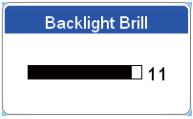
1. OPERATIONAL OVERVIEW
1.3How to Turn the Power On or Off
To turn the power ON, press  approx two seconds. Release when the FURUNO logo appears. It takes approx. 25-30 seconds to start the system, in the sequence shown below.
approx two seconds. Release when the FURUNO logo appears. It takes approx. 25-30 seconds to start the system, in the sequence shown below.
1)If some data is missing or is out of date, a message states the missing component. Contact your dealer for details.
2)If a C-MAP chart card is inserted, chart information is checked to see if it is up to date. If the chart is not up to date, the message "The chart data is out of data, and may be unsafe for navigation, which could place you and others at risk..." If this message appears contact your dealer to get up-to-date charts.
3)The unit beeps and shows the “Warnings - Limitations on Use” screen. Read the information then push the RotoKeyTM to start operation.
To turn the power OFF, press  until the message “Shutting down, please wait...” appears.
until the message “Shutting down, please wait...” appears.
1.4How to Adjust the Display Brilliance
You can adjust the display brilliance as follows:
1.Press the  key to show the [Backlight Brill] adjustment window.
key to show the [Backlight Brill] adjustment window.
2.Press the same key again to adjust the brilliance cyclically. The window shows the current level with analog and digital displays. The brilliance can also be adjusted with the RotoKeyTM. Ro-
tate the key clockwise to increase the brilliance, or counterclockwise to decrease the brilliance.
3.Press the ESC/MENU key to close the window.
1.52D Plotter Displays
The plotter provides a small world map. More detailed charts for your area are optionally available. The plotter section has functions to enter waypoints, and create and plan routes.
The plotter receives position information from the internal GPS receiver. Your position is marked on the screen with the own ship icon. You can change the shape of the icon from the menu. Waypoints and routes you have entered are shown on the display. You can move, delete and edit the waypoints and routes from a context-sensitive menu or through the menu.
The plotter display also
• Plots the track of your boat. |
• |
Controls alarm functions. |
|
• |
Measures distances and bearings. |
• |
Follows routes. |
• |
Marks man overboard (MOB) position. |
|
|
1-6
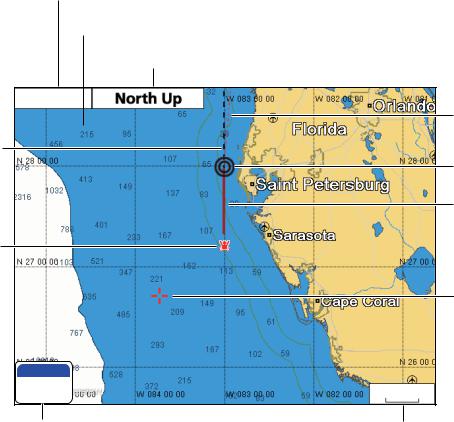
1. OPERATIONAL OVERVIEW
2D plotter display, vector chart
A vector chart is a series of points and lines that make up the features on a chart. Vector charts look computer generated. Details on the chart can be turned on and off. Objects on the chart can be clicked on to learn more details. Depths can be monitored to warn before grounding. When zooming in and out of a vector chart only the geographical features grow larger or smaller where text keeps it's same size and orientation.
Vector charts lack most topographical features.
Position fix state*
Alarm icon
Orientation mode (North Up, Course Up,
Auto Course Up, Heading Up)
GPS 3D
Compass 


COG line (black)
MOB mark
L/L grid
MOB |
|
180°T |
20 NM |
14.2 NM |
Heading line (red dashed line)
Own ship marker (black)
Track (default color is red)
Cursor (inactive, red)
MOB box |
Range scale |
(Bearing and range to MOB position) |
|
*Position fix state indications
GPS 2D: 2D position fix
GPS 3D: 3D position fix
GPSW2D: WAAS 2D position fix
GPSW3D: WAAS 3D position fix
NO FIX: No position data
SIM: Simulator mode
1-7
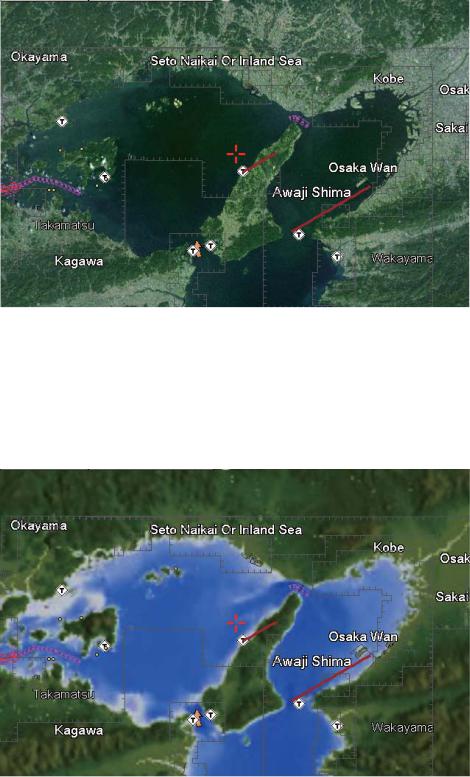
1. OPERATIONAL OVERVIEW
2D plotter display, vector/satellite
The vector chart plus a satellite photo. See chapter 6 for how to adjust the satellite display.
2D plotter display, raster
A raster chart is a direct copy or scan of an existing paper chart. Raster charts look identical to paper charts. All information contained within the chart is printed directly on it. What you see is what you get. When zooming in and out of a raster chart everything on the chart grows larger or smaller. When rotating a raster chart every thing on the chart rotates.
1-8
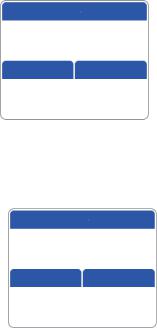
1. OPERATIONAL OVERVIEW
1.6The Cursor
The cursor has the functions shown below.
•Find, when put on respective item:
•Position, range and bearing to cursor location
•Point information
•Route information
•Track information
•AIS target information
•DSC information
•Tide information
•Object information
•Select a position for a waypoint on the plotter display.
•Select an item. For example, a waypoint on the plotter display.
The appearance of the cursor depends on its state - active or inactive.
To move the cursor, press any of the four arrows on the CursorPad. The cursor moves in the direction indicated on the pressed arrow.
|
|
|
|
|
|
|
: Active |
|
|
|
|
|
: Inactive (red) |
|
|
|
|
|
|||||||||
|
|
|
|
|
|
|
|
|
|
||||
|
|
|
|
|
|
|
|
|
|
|
|
||
|
|
|
|
|
|
|
|
|
|
|
|
|
|
|
|
|
|
|
|
|
|
|
|
|
|
|
|
|
|
|
|
|
|
|
|
|
|
|
|
|
|
How to find cursor position, range and bearing to cursor position
Press any of the four arrows on the CursorPad to move the cursor in the direction indicated on the pressed arrow. The cursor position and the distance and bearing from your boat to the cursor position are displayed.
Position
Cursor position in |
|
|
43°59.2157'N |
|
||
|
|
135°16.6498'E |
|
|||
latitude and longitude |
|
|
||||
DST NM |
BRG T |
|
||||
|
|
|
||||
Distance to |
|
|
10.5 |
185° |
|
Bearing to |
|
|
|
||||
cursor position |
|
|
|
|
cursor position |
|
How to find current position, SOG and COG
Put the cursor on the own ship icon to find current position, SOG and COG.
Position
Cursor position in |
|
|
43°22.1834'N |
|
||
|
|
134°26.3465'E |
|
|||
latitude and longitude |
|
|
||||
SOG kn |
COG T |
|
||||
|
|
|
||||
Speed over |
|
|
12.2 |
155° |
|
Course over |
|
|
|
||||
the ground |
|
|
|
|
the ground |
|
1-9
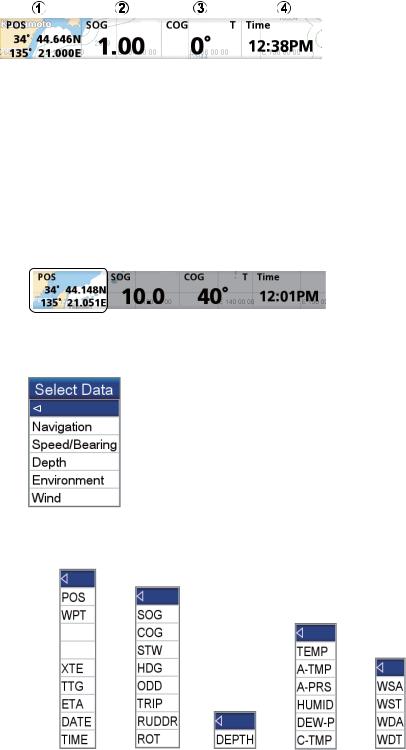
1. OPERATIONAL OVERVIEW
1.7Navigation Data Boxes
The navigation data boxes, displayed at the bottom of the screen, show various navigation data fed from the sensors connected to the display unit. Two or four boxes can be displayed and you can freely change the data shown in each box. The data that you can show depends on your system configuration. The boxes can be shown or hidden with the [Nav Data] soft control.
kn
Note: Waypoint name, distance to WPT, bearing to WPT, XTE, TTG and ETA are not available unless you are navigating to a point or route. Bars (--) are shown in the respective box when the data is not available.
1.7.1How to select the data to display in a box
1.Open the full RotoKey menu then choose [Select Data]. The background color of all but one of the boxes is grey.
Box not greyed out is currently selected box.
kn
2.Rotate the RotoKeyTM to select the data box to change then push the key to show the [Select Data] (data category) window.
3.Select a data box category, and a window with choices relevant to your selection appears.
DST
BRG
Navigation |
Speed/ |
Depth |
Environment |
Wind |
|
Bearing |
|
|
|
4. Select the data desired.
1-10
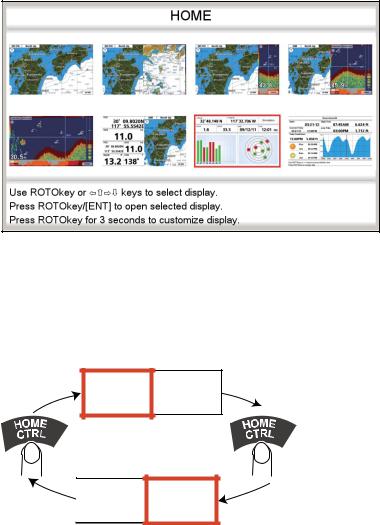
1. OPERATIONAL OVERVIEW
1.8Home Screen (Display Selection)
1.8.1How to select a display
The home screen has eight displays from which to choose. Press the HOME/CTRL
key to show the home screen. Operate the CursorPad or rotate the RotoKeyTM to select a display. The current selection is circumscribed with a red rectangle. Press the
RotoKeyTM or ENT key to confirm your selection.
1.8.2How to switch the active screen
In multi-split screens, you can switch the active screen with the HOME/CTRL key. Long-press the key to select the screen to make active. The active screen is circumscribed with a red rectangle.
|
ACTIVE |
|
ACTIVE |
|
CTRL CTRL |
Long |
Long |
press |
press |
ACTIVE
AC IVE ACTIVE
1-11
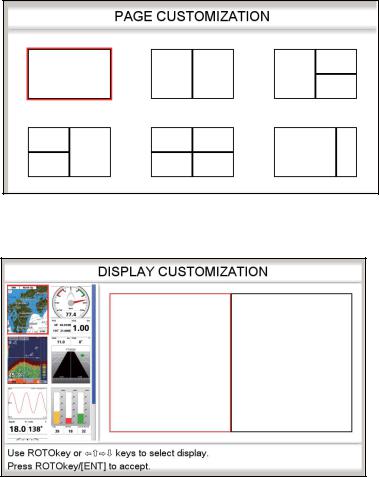
1. OPERATIONAL OVERVIEW
1.8.3How to customize the home screen
The home screen has seven screens that you can customize. (The full-screen plotter display cannot be customized. If you try to customize this display, the message “Can’t customize this display.” appears.) You can split the screen in up to four separate segments. In each segment you can select the following displays:
Screen |
Displays available |
|
|
Single screen |
Plotter, fish finder, tide and celestial, GPS status |
|
|
Half screen |
Plotter, fish finder, highway, wind angle meter, meter (speed, water |
|
temperature/temperature, engine), graph, tank |
|
|
Quarter screen |
Navigation data, steering, wind angle meter, meter (same choices as |
|
for half screen), graph, tank |
|
|
Follow the procedure below to customize a home screen. As an example, the procedure shows how to put the plotter display and fish finder display on the halves screen.
1.Press the HOME/CTRL key to show the home screen.
2.Use the RotoKeyTM to select the screen to customize.
3.Long-push the RotoKeyTM to show the [PAGE CUSTOMIZATION] screen.
4.Select the division desired then push the RotoKeyTM. For example, select the halves screen. The [DISPLAY CUSTOMIZATION] screen appears.
The rectangle cursor (red) in the screen selection area circumscribes the screen
division currently selected. If necessary, use the RotoKeyTM to select a screen division.
1-12
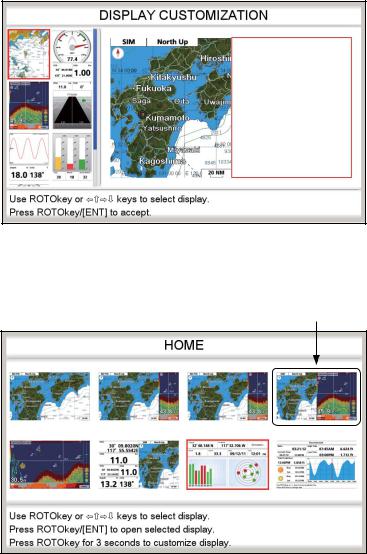
1. OPERATIONAL OVERVIEW
5.Select a display then push the RotoKeyTM. For example, select the plotter display. The chosen display appears at the location selected and the rectangle cursor moves to the adjacent screen.
6.Select a display for the right half then push the RotoKeyTM. For example, select the fish finder display. Control is returned to the home screen, where you can see the result of your selection.
Plotter, fish finder display
1-13
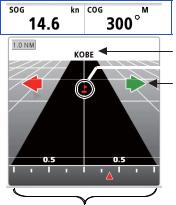
1. OPERATIONAL OVERVIEW
1.8.4Description of home screen displays
Full screen displays
Plotter: See page 1-7.
Fish finder: See chapter 7.
Tide & Celestial: Your plotter provides for calculation of the tide heights for any date. Additionally this display shows the time of sunrise, sunset, moonrise and moonset. See section 1.17.
GPS status display: The GPS status display shows the location and RX signal strength of each satellite being received. See section 12.4.
Half screen displays
The half screen displays provide the plotter display, highway display, navigation data, and navigation data plus a graphic display (graph or meter). In most displays the data can be changed. See the end of this section for how to change data.
Plotter: See page 1-7.
Highway: The highway display provides a graphic presentation of your boat’s track along intended course, and is useful for monitoring ship's progress toward a waypoint.
You can zoom in and zoom out the display by rotating the RotoKeyTM. The vertical line at the center of the screen is your intended course and the name of the waypoint you are steering to is at top of the line. Steer your boat so that the own ship marker in the XTE scale stays near zero. If you go off course, the direction to steer to return to your course is indicated with the color-coded steer direction arrow. The arrow is red when you should steer to port; green when you should steer to starboard. The width of the navigation lane (black area in the figure below) and the XTE (cross-track error) range scale are equal to the XTE alarm setting. In the example illustration, the boat is
off course to the starboard side by approx 0.3 nm. Rotate the RotoKeyTM to change the display range.
Display range 
Steer direction arrow (red)  (Steer left to keep course.)
(Steer left to keep course.)
 Navigation data (selectable)
Navigation data (selectable)
WPT name
 Waypoint (red)
Waypoint (red)
Steer direction arrow (green) (Steer right to keep course.)
Note: Both steer direction arrows are not displayed at the same time in actual operation. They are displayed here for demonstration purpose.
 Own ship marker (red)
Own ship marker (red)
XTE range scale (equal to XTE alarm range)
1-14
